Clinical Placement Reflection Report: Radiology, Australia 2018
VerifiedAdded on 2021/06/16
|10
|2331
|493
Report
AI Summary
This report is a reflection on a clinical placement undertaken by a radiology student in an outpatient unit of a local hospital in Australia. The student details their experiences as a radiographer, including radiography practices, theatre work, and fluoroscopy procedures. The report highlights the challenges and learning opportunities encountered, emphasizing the importance of patient interaction, communication, and adherence to professional ethics. The student describes their involvement in various clinical activities, such as barium X-rays and surgical procedures, and how these experiences contributed to their understanding of the responsibilities and skills required of a radiographer. The report concludes with an evaluation of the placement's impact on the student's professional development, highlighting the transition from a student to a professional radiographer and the acquisition of essential clinical competencies.
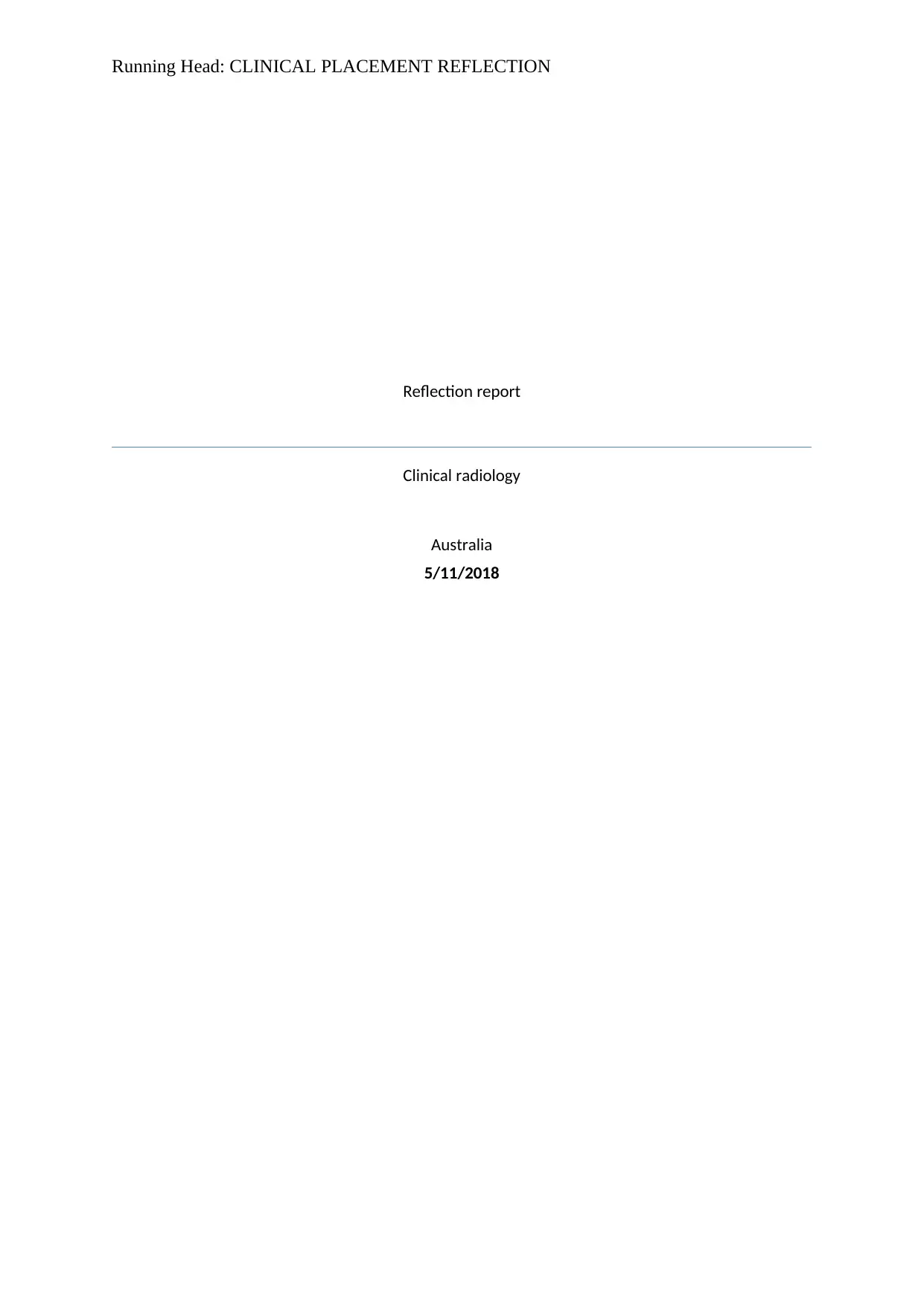
Running Head: CLINICAL PLACEMENT REFLECTION
Reflection report
Clinical radiology
Australia
5/11/2018
Reflection report
Clinical radiology
Australia
5/11/2018
Paraphrase This Document
Need a fresh take? Get an instant paraphrase of this document with our AI Paraphraser
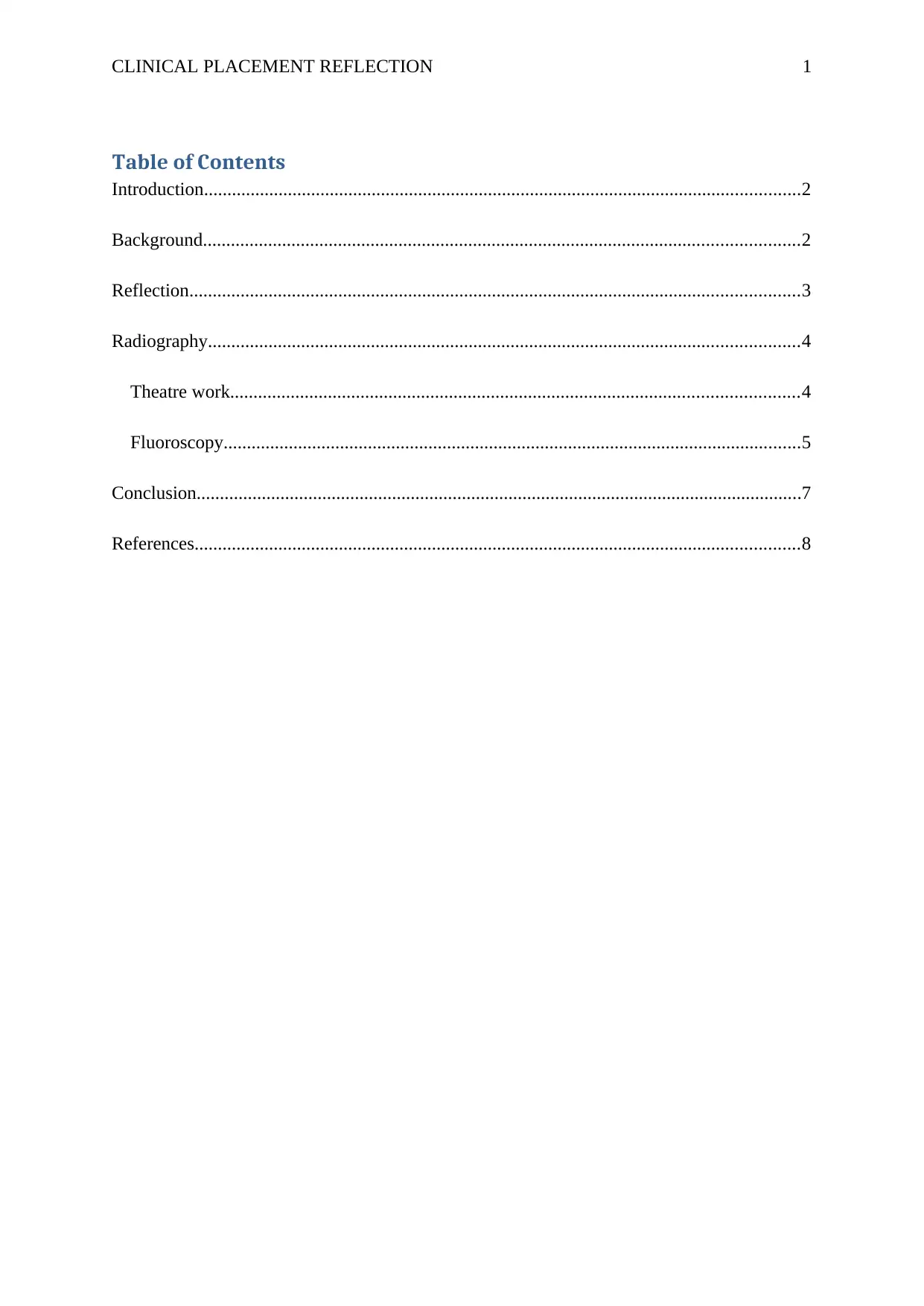
CLINICAL PLACEMENT REFLECTION 1
Table of Contents
Introduction................................................................................................................................2
Background................................................................................................................................2
Reflection...................................................................................................................................3
Radiography...............................................................................................................................4
Theatre work..........................................................................................................................4
Fluoroscopy............................................................................................................................5
Conclusion..................................................................................................................................7
References..................................................................................................................................8
Table of Contents
Introduction................................................................................................................................2
Background................................................................................................................................2
Reflection...................................................................................................................................3
Radiography...............................................................................................................................4
Theatre work..........................................................................................................................4
Fluoroscopy............................................................................................................................5
Conclusion..................................................................................................................................7
References..................................................................................................................................8
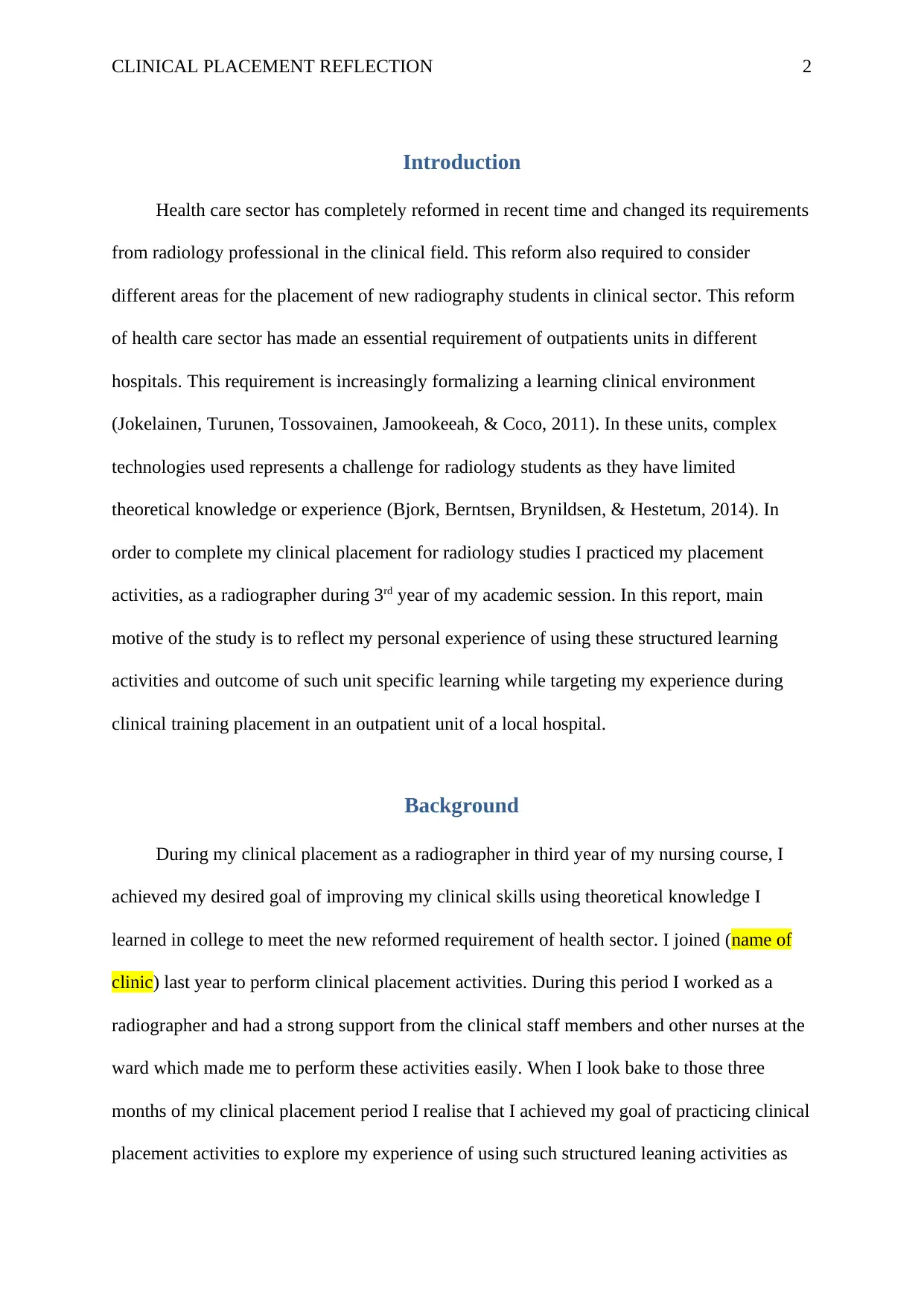
CLINICAL PLACEMENT REFLECTION 2
Introduction
Health care sector has completely reformed in recent time and changed its requirements
from radiology professional in the clinical field. This reform also required to consider
different areas for the placement of new radiography students in clinical sector. This reform
of health care sector has made an essential requirement of outpatients units in different
hospitals. This requirement is increasingly formalizing a learning clinical environment
(Jokelainen, Turunen, Tossovainen, Jamookeeah, & Coco, 2011). In these units, complex
technologies used represents a challenge for radiology students as they have limited
theoretical knowledge or experience (Bjork, Berntsen, Brynildsen, & Hestetum, 2014). In
order to complete my clinical placement for radiology studies I practiced my placement
activities, as a radiographer during 3rd year of my academic session. In this report, main
motive of the study is to reflect my personal experience of using these structured learning
activities and outcome of such unit specific learning while targeting my experience during
clinical training placement in an outpatient unit of a local hospital.
Background
During my clinical placement as a radiographer in third year of my nursing course, I
achieved my desired goal of improving my clinical skills using theoretical knowledge I
learned in college to meet the new reformed requirement of health sector. I joined (name of
clinic) last year to perform clinical placement activities. During this period I worked as a
radiographer and had a strong support from the clinical staff members and other nurses at the
ward which made me to perform these activities easily. When I look bake to those three
months of my clinical placement period I realise that I achieved my goal of practicing clinical
placement activities to explore my experience of using such structured leaning activities as
Introduction
Health care sector has completely reformed in recent time and changed its requirements
from radiology professional in the clinical field. This reform also required to consider
different areas for the placement of new radiography students in clinical sector. This reform
of health care sector has made an essential requirement of outpatients units in different
hospitals. This requirement is increasingly formalizing a learning clinical environment
(Jokelainen, Turunen, Tossovainen, Jamookeeah, & Coco, 2011). In these units, complex
technologies used represents a challenge for radiology students as they have limited
theoretical knowledge or experience (Bjork, Berntsen, Brynildsen, & Hestetum, 2014). In
order to complete my clinical placement for radiology studies I practiced my placement
activities, as a radiographer during 3rd year of my academic session. In this report, main
motive of the study is to reflect my personal experience of using these structured learning
activities and outcome of such unit specific learning while targeting my experience during
clinical training placement in an outpatient unit of a local hospital.
Background
During my clinical placement as a radiographer in third year of my nursing course, I
achieved my desired goal of improving my clinical skills using theoretical knowledge I
learned in college to meet the new reformed requirement of health sector. I joined (name of
clinic) last year to perform clinical placement activities. During this period I worked as a
radiographer and had a strong support from the clinical staff members and other nurses at the
ward which made me to perform these activities easily. When I look bake to those three
months of my clinical placement period I realise that I achieved my goal of practicing clinical
placement activities to explore my experience of using such structured leaning activities as
⊘ This is a preview!⊘
Do you want full access?
Subscribe today to unlock all pages.

Trusted by 1+ million students worldwide
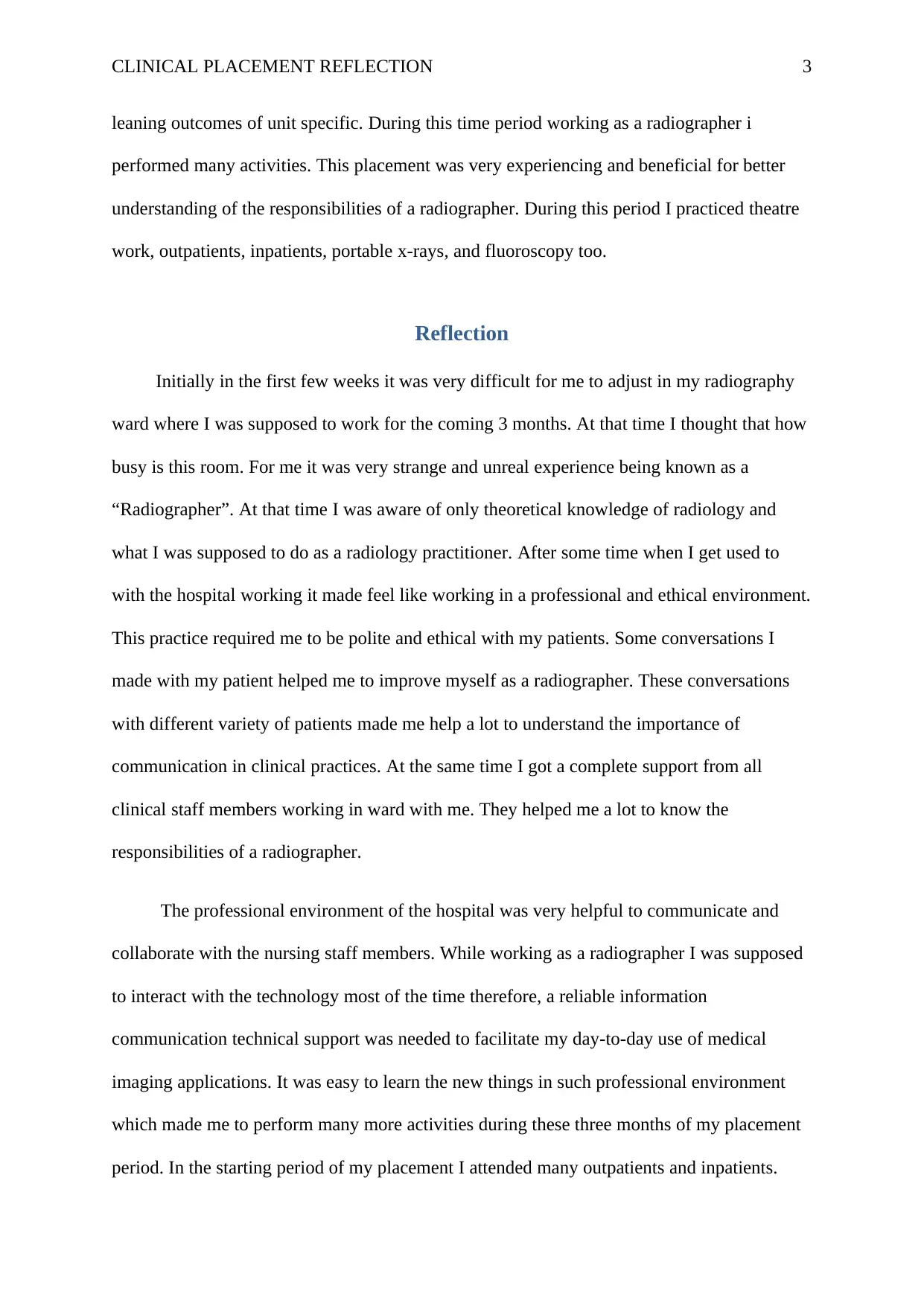
CLINICAL PLACEMENT REFLECTION 3
leaning outcomes of unit specific. During this time period working as a radiographer i
performed many activities. This placement was very experiencing and beneficial for better
understanding of the responsibilities of a radiographer. During this period I practiced theatre
work, outpatients, inpatients, portable x-rays, and fluoroscopy too.
Reflection
Initially in the first few weeks it was very difficult for me to adjust in my radiography
ward where I was supposed to work for the coming 3 months. At that time I thought that how
busy is this room. For me it was very strange and unreal experience being known as a
“Radiographer”. At that time I was aware of only theoretical knowledge of radiology and
what I was supposed to do as a radiology practitioner. After some time when I get used to
with the hospital working it made feel like working in a professional and ethical environment.
This practice required me to be polite and ethical with my patients. Some conversations I
made with my patient helped me to improve myself as a radiographer. These conversations
with different variety of patients made me help a lot to understand the importance of
communication in clinical practices. At the same time I got a complete support from all
clinical staff members working in ward with me. They helped me a lot to know the
responsibilities of a radiographer.
The professional environment of the hospital was very helpful to communicate and
collaborate with the nursing staff members. While working as a radiographer I was supposed
to interact with the technology most of the time therefore, a reliable information
communication technical support was needed to facilitate my day-to-day use of medical
imaging applications. It was easy to learn the new things in such professional environment
which made me to perform many more activities during these three months of my placement
period. In the starting period of my placement I attended many outpatients and inpatients.
leaning outcomes of unit specific. During this time period working as a radiographer i
performed many activities. This placement was very experiencing and beneficial for better
understanding of the responsibilities of a radiographer. During this period I practiced theatre
work, outpatients, inpatients, portable x-rays, and fluoroscopy too.
Reflection
Initially in the first few weeks it was very difficult for me to adjust in my radiography
ward where I was supposed to work for the coming 3 months. At that time I thought that how
busy is this room. For me it was very strange and unreal experience being known as a
“Radiographer”. At that time I was aware of only theoretical knowledge of radiology and
what I was supposed to do as a radiology practitioner. After some time when I get used to
with the hospital working it made feel like working in a professional and ethical environment.
This practice required me to be polite and ethical with my patients. Some conversations I
made with my patient helped me to improve myself as a radiographer. These conversations
with different variety of patients made me help a lot to understand the importance of
communication in clinical practices. At the same time I got a complete support from all
clinical staff members working in ward with me. They helped me a lot to know the
responsibilities of a radiographer.
The professional environment of the hospital was very helpful to communicate and
collaborate with the nursing staff members. While working as a radiographer I was supposed
to interact with the technology most of the time therefore, a reliable information
communication technical support was needed to facilitate my day-to-day use of medical
imaging applications. It was easy to learn the new things in such professional environment
which made me to perform many more activities during these three months of my placement
period. In the starting period of my placement I attended many outpatients and inpatients.
Paraphrase This Document
Need a fresh take? Get an instant paraphrase of this document with our AI Paraphraser
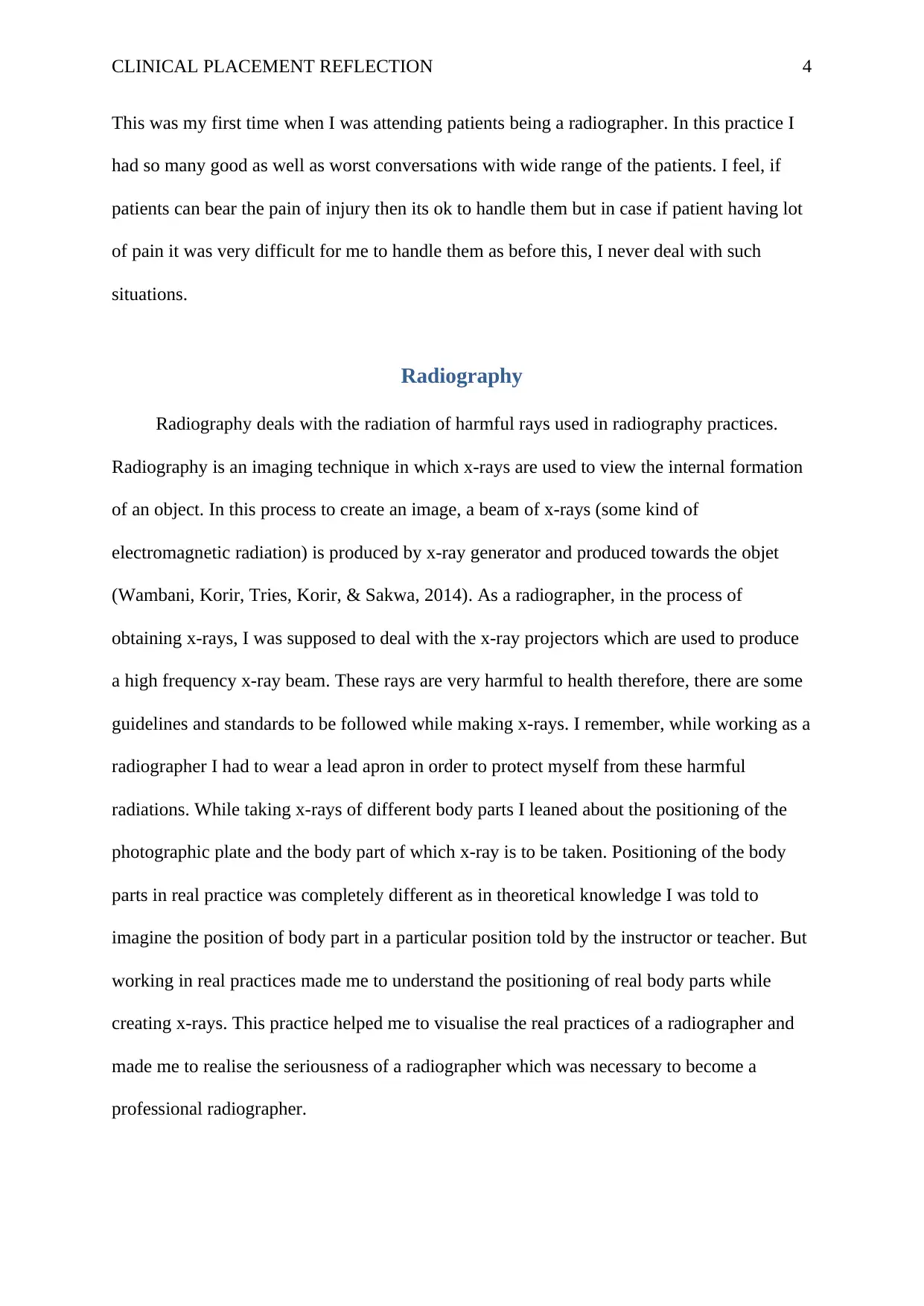
CLINICAL PLACEMENT REFLECTION 4
This was my first time when I was attending patients being a radiographer. In this practice I
had so many good as well as worst conversations with wide range of the patients. I feel, if
patients can bear the pain of injury then its ok to handle them but in case if patient having lot
of pain it was very difficult for me to handle them as before this, I never deal with such
situations.
Radiography
Radiography deals with the radiation of harmful rays used in radiography practices.
Radiography is an imaging technique in which x-rays are used to view the internal formation
of an object. In this process to create an image, a beam of x-rays (some kind of
electromagnetic radiation) is produced by x-ray generator and produced towards the objet
(Wambani, Korir, Tries, Korir, & Sakwa, 2014). As a radiographer, in the process of
obtaining x-rays, I was supposed to deal with the x-ray projectors which are used to produce
a high frequency x-ray beam. These rays are very harmful to health therefore, there are some
guidelines and standards to be followed while making x-rays. I remember, while working as a
radiographer I had to wear a lead apron in order to protect myself from these harmful
radiations. While taking x-rays of different body parts I leaned about the positioning of the
photographic plate and the body part of which x-ray is to be taken. Positioning of the body
parts in real practice was completely different as in theoretical knowledge I was told to
imagine the position of body part in a particular position told by the instructor or teacher. But
working in real practices made me to understand the positioning of real body parts while
creating x-rays. This practice helped me to visualise the real practices of a radiographer and
made me to realise the seriousness of a radiographer which was necessary to become a
professional radiographer.
This was my first time when I was attending patients being a radiographer. In this practice I
had so many good as well as worst conversations with wide range of the patients. I feel, if
patients can bear the pain of injury then its ok to handle them but in case if patient having lot
of pain it was very difficult for me to handle them as before this, I never deal with such
situations.
Radiography
Radiography deals with the radiation of harmful rays used in radiography practices.
Radiography is an imaging technique in which x-rays are used to view the internal formation
of an object. In this process to create an image, a beam of x-rays (some kind of
electromagnetic radiation) is produced by x-ray generator and produced towards the objet
(Wambani, Korir, Tries, Korir, & Sakwa, 2014). As a radiographer, in the process of
obtaining x-rays, I was supposed to deal with the x-ray projectors which are used to produce
a high frequency x-ray beam. These rays are very harmful to health therefore, there are some
guidelines and standards to be followed while making x-rays. I remember, while working as a
radiographer I had to wear a lead apron in order to protect myself from these harmful
radiations. While taking x-rays of different body parts I leaned about the positioning of the
photographic plate and the body part of which x-ray is to be taken. Positioning of the body
parts in real practice was completely different as in theoretical knowledge I was told to
imagine the position of body part in a particular position told by the instructor or teacher. But
working in real practices made me to understand the positioning of real body parts while
creating x-rays. This practice helped me to visualise the real practices of a radiographer and
made me to realise the seriousness of a radiographer which was necessary to become a
professional radiographer.
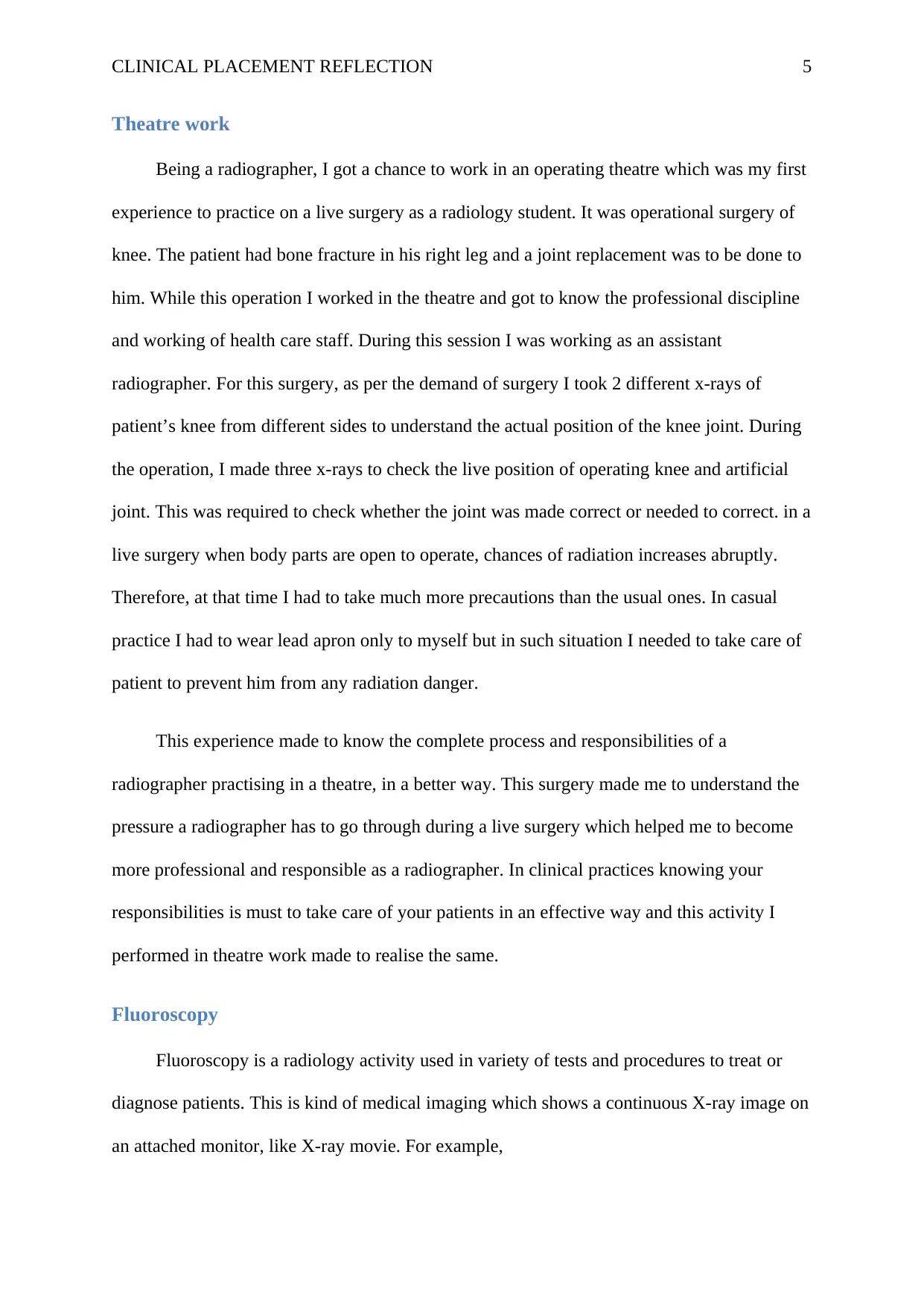
CLINICAL PLACEMENT REFLECTION 5
Theatre work
Being a radiographer, I got a chance to work in an operating theatre which was my first
experience to practice on a live surgery as a radiology student. It was operational surgery of
knee. The patient had bone fracture in his right leg and a joint replacement was to be done to
him. While this operation I worked in the theatre and got to know the professional discipline
and working of health care staff. During this session I was working as an assistant
radiographer. For this surgery, as per the demand of surgery I took 2 different x-rays of
patient’s knee from different sides to understand the actual position of the knee joint. During
the operation, I made three x-rays to check the live position of operating knee and artificial
joint. This was required to check whether the joint was made correct or needed to correct. in a
live surgery when body parts are open to operate, chances of radiation increases abruptly.
Therefore, at that time I had to take much more precautions than the usual ones. In casual
practice I had to wear lead apron only to myself but in such situation I needed to take care of
patient to prevent him from any radiation danger.
This experience made to know the complete process and responsibilities of a
radiographer practising in a theatre, in a better way. This surgery made me to understand the
pressure a radiographer has to go through during a live surgery which helped me to become
more professional and responsible as a radiographer. In clinical practices knowing your
responsibilities is must to take care of your patients in an effective way and this activity I
performed in theatre work made to realise the same.
Fluoroscopy
Fluoroscopy is a radiology activity used in variety of tests and procedures to treat or
diagnose patients. This is kind of medical imaging which shows a continuous X-ray image on
an attached monitor, like X-ray movie. For example,
Theatre work
Being a radiographer, I got a chance to work in an operating theatre which was my first
experience to practice on a live surgery as a radiology student. It was operational surgery of
knee. The patient had bone fracture in his right leg and a joint replacement was to be done to
him. While this operation I worked in the theatre and got to know the professional discipline
and working of health care staff. During this session I was working as an assistant
radiographer. For this surgery, as per the demand of surgery I took 2 different x-rays of
patient’s knee from different sides to understand the actual position of the knee joint. During
the operation, I made three x-rays to check the live position of operating knee and artificial
joint. This was required to check whether the joint was made correct or needed to correct. in a
live surgery when body parts are open to operate, chances of radiation increases abruptly.
Therefore, at that time I had to take much more precautions than the usual ones. In casual
practice I had to wear lead apron only to myself but in such situation I needed to take care of
patient to prevent him from any radiation danger.
This experience made to know the complete process and responsibilities of a
radiographer practising in a theatre, in a better way. This surgery made me to understand the
pressure a radiographer has to go through during a live surgery which helped me to become
more professional and responsible as a radiographer. In clinical practices knowing your
responsibilities is must to take care of your patients in an effective way and this activity I
performed in theatre work made to realise the same.
Fluoroscopy
Fluoroscopy is a radiology activity used in variety of tests and procedures to treat or
diagnose patients. This is kind of medical imaging which shows a continuous X-ray image on
an attached monitor, like X-ray movie. For example,
⊘ This is a preview!⊘
Do you want full access?
Subscribe today to unlock all pages.

Trusted by 1+ million students worldwide
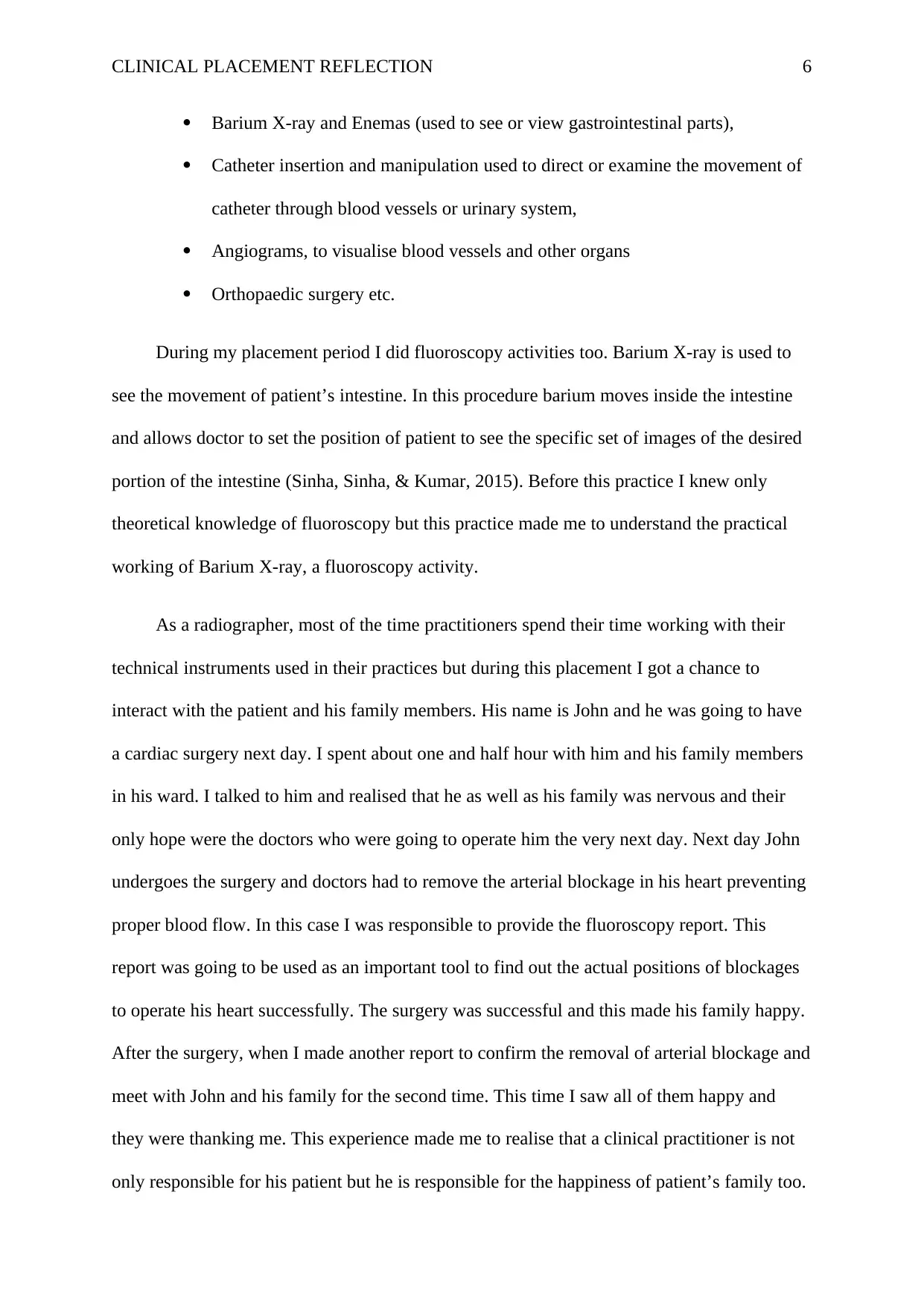
CLINICAL PLACEMENT REFLECTION 6
Barium X-ray and Enemas (used to see or view gastrointestinal parts),
Catheter insertion and manipulation used to direct or examine the movement of
catheter through blood vessels or urinary system,
Angiograms, to visualise blood vessels and other organs
Orthopaedic surgery etc.
During my placement period I did fluoroscopy activities too. Barium X-ray is used to
see the movement of patient’s intestine. In this procedure barium moves inside the intestine
and allows doctor to set the position of patient to see the specific set of images of the desired
portion of the intestine (Sinha, Sinha, & Kumar, 2015). Before this practice I knew only
theoretical knowledge of fluoroscopy but this practice made me to understand the practical
working of Barium X-ray, a fluoroscopy activity.
As a radiographer, most of the time practitioners spend their time working with their
technical instruments used in their practices but during this placement I got a chance to
interact with the patient and his family members. His name is John and he was going to have
a cardiac surgery next day. I spent about one and half hour with him and his family members
in his ward. I talked to him and realised that he as well as his family was nervous and their
only hope were the doctors who were going to operate him the very next day. Next day John
undergoes the surgery and doctors had to remove the arterial blockage in his heart preventing
proper blood flow. In this case I was responsible to provide the fluoroscopy report. This
report was going to be used as an important tool to find out the actual positions of blockages
to operate his heart successfully. The surgery was successful and this made his family happy.
After the surgery, when I made another report to confirm the removal of arterial blockage and
meet with John and his family for the second time. This time I saw all of them happy and
they were thanking me. This experience made me to realise that a clinical practitioner is not
only responsible for his patient but he is responsible for the happiness of patient’s family too.
Barium X-ray and Enemas (used to see or view gastrointestinal parts),
Catheter insertion and manipulation used to direct or examine the movement of
catheter through blood vessels or urinary system,
Angiograms, to visualise blood vessels and other organs
Orthopaedic surgery etc.
During my placement period I did fluoroscopy activities too. Barium X-ray is used to
see the movement of patient’s intestine. In this procedure barium moves inside the intestine
and allows doctor to set the position of patient to see the specific set of images of the desired
portion of the intestine (Sinha, Sinha, & Kumar, 2015). Before this practice I knew only
theoretical knowledge of fluoroscopy but this practice made me to understand the practical
working of Barium X-ray, a fluoroscopy activity.
As a radiographer, most of the time practitioners spend their time working with their
technical instruments used in their practices but during this placement I got a chance to
interact with the patient and his family members. His name is John and he was going to have
a cardiac surgery next day. I spent about one and half hour with him and his family members
in his ward. I talked to him and realised that he as well as his family was nervous and their
only hope were the doctors who were going to operate him the very next day. Next day John
undergoes the surgery and doctors had to remove the arterial blockage in his heart preventing
proper blood flow. In this case I was responsible to provide the fluoroscopy report. This
report was going to be used as an important tool to find out the actual positions of blockages
to operate his heart successfully. The surgery was successful and this made his family happy.
After the surgery, when I made another report to confirm the removal of arterial blockage and
meet with John and his family for the second time. This time I saw all of them happy and
they were thanking me. This experience made me to realise that a clinical practitioner is not
only responsible for his patient but he is responsible for the happiness of patient’s family too.
Paraphrase This Document
Need a fresh take? Get an instant paraphrase of this document with our AI Paraphraser
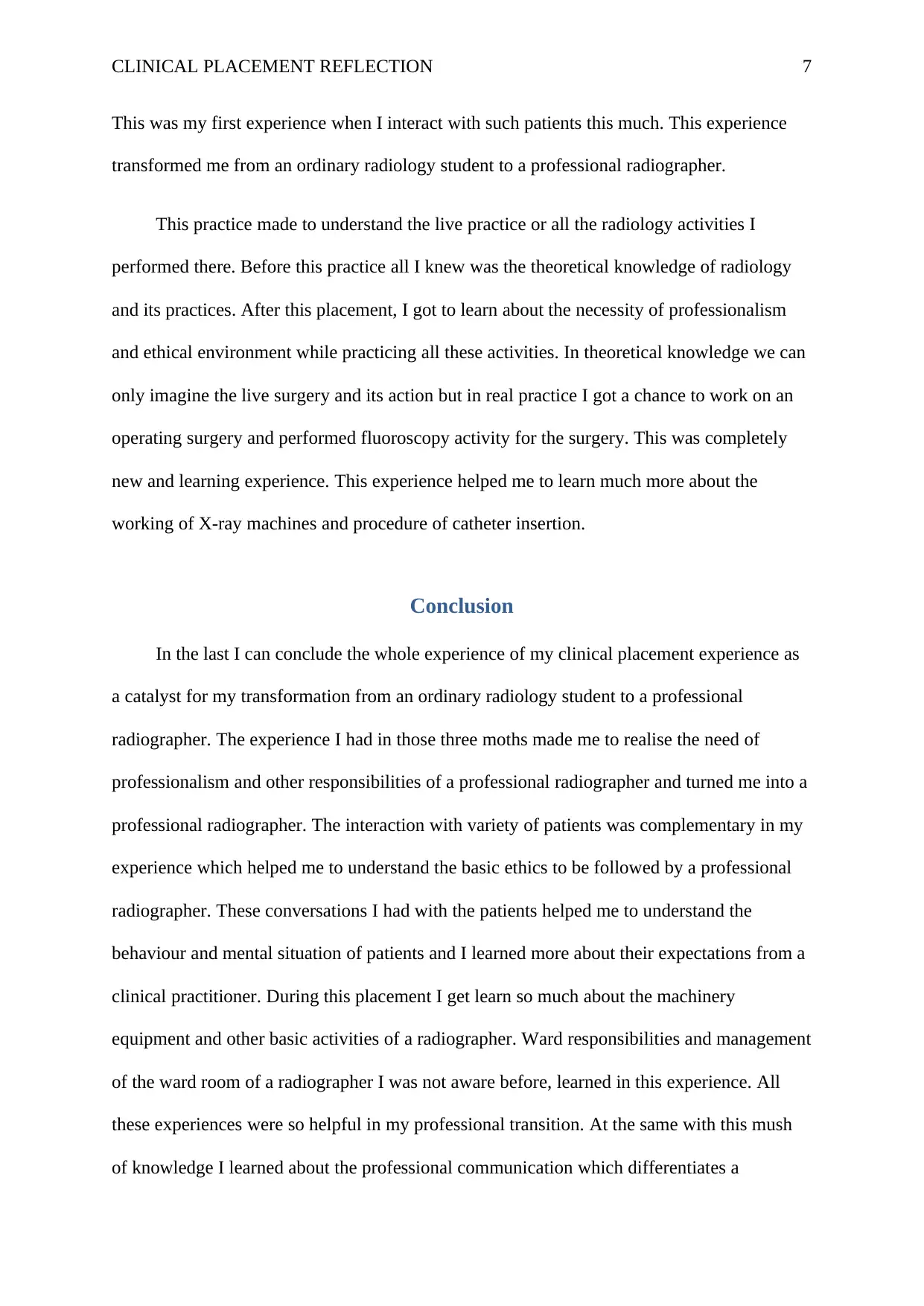
CLINICAL PLACEMENT REFLECTION 7
This was my first experience when I interact with such patients this much. This experience
transformed me from an ordinary radiology student to a professional radiographer.
This practice made to understand the live practice or all the radiology activities I
performed there. Before this practice all I knew was the theoretical knowledge of radiology
and its practices. After this placement, I got to learn about the necessity of professionalism
and ethical environment while practicing all these activities. In theoretical knowledge we can
only imagine the live surgery and its action but in real practice I got a chance to work on an
operating surgery and performed fluoroscopy activity for the surgery. This was completely
new and learning experience. This experience helped me to learn much more about the
working of X-ray machines and procedure of catheter insertion.
Conclusion
In the last I can conclude the whole experience of my clinical placement experience as
a catalyst for my transformation from an ordinary radiology student to a professional
radiographer. The experience I had in those three moths made me to realise the need of
professionalism and other responsibilities of a professional radiographer and turned me into a
professional radiographer. The interaction with variety of patients was complementary in my
experience which helped me to understand the basic ethics to be followed by a professional
radiographer. These conversations I had with the patients helped me to understand the
behaviour and mental situation of patients and I learned more about their expectations from a
clinical practitioner. During this placement I get learn so much about the machinery
equipment and other basic activities of a radiographer. Ward responsibilities and management
of the ward room of a radiographer I was not aware before, learned in this experience. All
these experiences were so helpful in my professional transition. At the same with this mush
of knowledge I learned about the professional communication which differentiates a
This was my first experience when I interact with such patients this much. This experience
transformed me from an ordinary radiology student to a professional radiographer.
This practice made to understand the live practice or all the radiology activities I
performed there. Before this practice all I knew was the theoretical knowledge of radiology
and its practices. After this placement, I got to learn about the necessity of professionalism
and ethical environment while practicing all these activities. In theoretical knowledge we can
only imagine the live surgery and its action but in real practice I got a chance to work on an
operating surgery and performed fluoroscopy activity for the surgery. This was completely
new and learning experience. This experience helped me to learn much more about the
working of X-ray machines and procedure of catheter insertion.
Conclusion
In the last I can conclude the whole experience of my clinical placement experience as
a catalyst for my transformation from an ordinary radiology student to a professional
radiographer. The experience I had in those three moths made me to realise the need of
professionalism and other responsibilities of a professional radiographer and turned me into a
professional radiographer. The interaction with variety of patients was complementary in my
experience which helped me to understand the basic ethics to be followed by a professional
radiographer. These conversations I had with the patients helped me to understand the
behaviour and mental situation of patients and I learned more about their expectations from a
clinical practitioner. During this placement I get learn so much about the machinery
equipment and other basic activities of a radiographer. Ward responsibilities and management
of the ward room of a radiographer I was not aware before, learned in this experience. All
these experiences were so helpful in my professional transition. At the same with this mush
of knowledge I learned about the professional communication which differentiates a
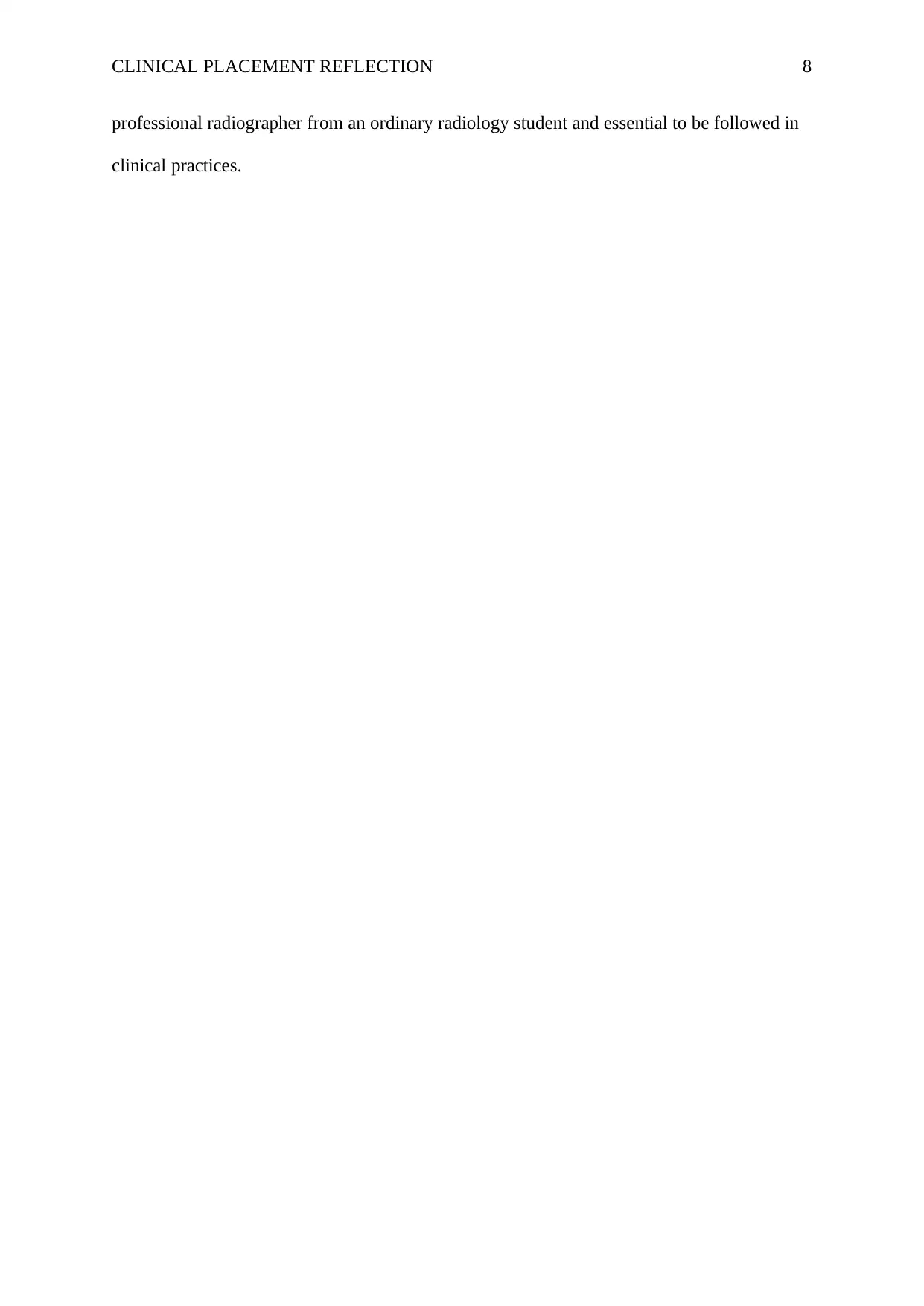
CLINICAL PLACEMENT REFLECTION 8
professional radiographer from an ordinary radiology student and essential to be followed in
clinical practices.
professional radiographer from an ordinary radiology student and essential to be followed in
clinical practices.
⊘ This is a preview!⊘
Do you want full access?
Subscribe today to unlock all pages.

Trusted by 1+ million students worldwide

CLINICAL PLACEMENT REFLECTION 9
References
Bjork, I. T., Berntsen, K., Brynildsen, G., & Hestetum, M. (2014). Nursing Students'
Perception of Their Clinical Learning Environment in Placements Outside Traditional
Hospital Settings. Journal of Clinical Nursing, 23, 2958-2967.
Jokelainen, M., Turunen, H., Tossovainen, K., Jamookeeah, D., & Coco, K. (2011). A
Systematic Review of Mentoring Nursing Students in Clinical Placements. Journal of
Clinical Nursing, 20, 2854-2867.
Sinha, M. K., Sinha, R. K., & Kumar, G. (2015). Retained Berium in the Appendix or Right
Ureteric Colic? A Case Report of Surgeons Dilemma. Internatioanl Journal of
Surgery Case Reports, 7, 23-25.
Wambani, J. S., Korir, G. K., Tries, M. A., Korir, I. k., & Sakwa, J. M. (2014). Patient
Radiation Exposure During General Fluoroscopy Examinations. Journal of Applied
Clinical Medical Physics, 15(2), 262-270.
References
Bjork, I. T., Berntsen, K., Brynildsen, G., & Hestetum, M. (2014). Nursing Students'
Perception of Their Clinical Learning Environment in Placements Outside Traditional
Hospital Settings. Journal of Clinical Nursing, 23, 2958-2967.
Jokelainen, M., Turunen, H., Tossovainen, K., Jamookeeah, D., & Coco, K. (2011). A
Systematic Review of Mentoring Nursing Students in Clinical Placements. Journal of
Clinical Nursing, 20, 2854-2867.
Sinha, M. K., Sinha, R. K., & Kumar, G. (2015). Retained Berium in the Appendix or Right
Ureteric Colic? A Case Report of Surgeons Dilemma. Internatioanl Journal of
Surgery Case Reports, 7, 23-25.
Wambani, J. S., Korir, G. K., Tries, M. A., Korir, I. k., & Sakwa, J. M. (2014). Patient
Radiation Exposure During General Fluoroscopy Examinations. Journal of Applied
Clinical Medical Physics, 15(2), 262-270.
1 out of 10
Related Documents
Your All-in-One AI-Powered Toolkit for Academic Success.
+13062052269
info@desklib.com
Available 24*7 on WhatsApp / Email
![[object Object]](/_next/static/media/star-bottom.7253800d.svg)
Unlock your academic potential
Copyright © 2020–2025 A2Z Services. All Rights Reserved. Developed and managed by ZUCOL.





